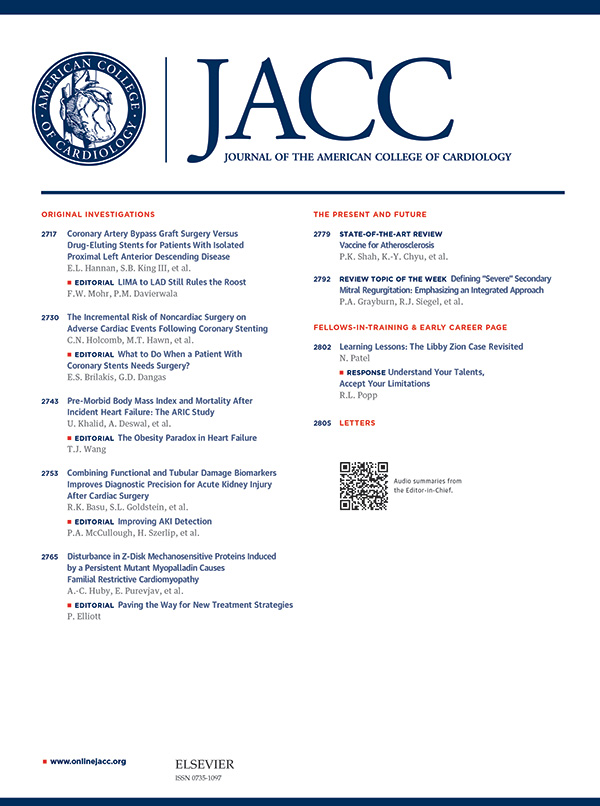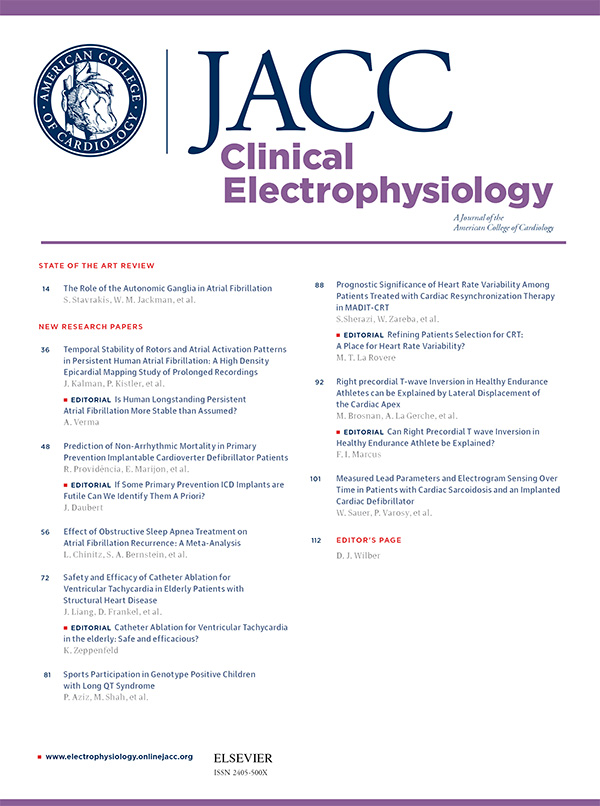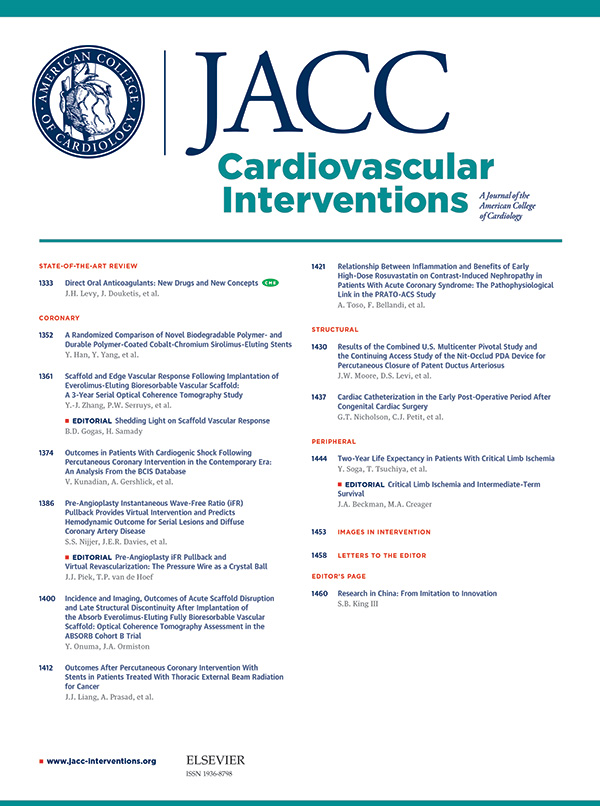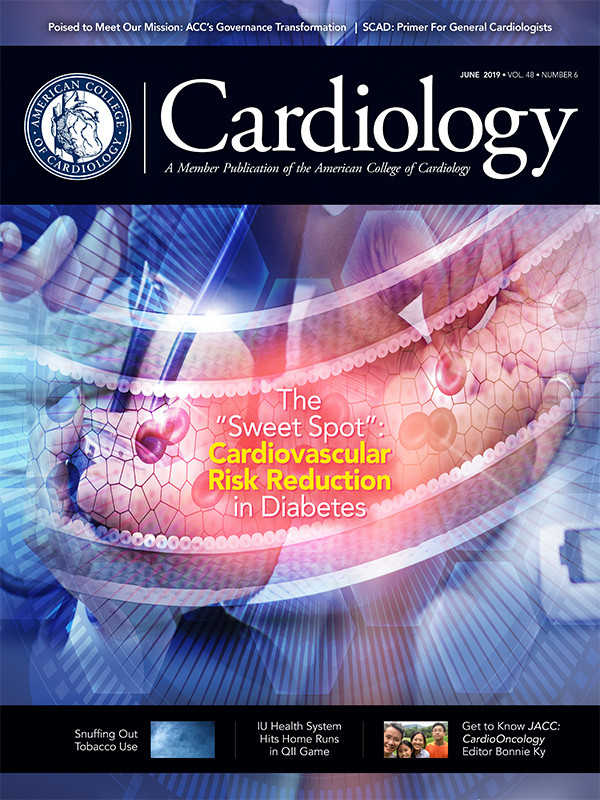JACC in a Flash
Featured topics and Editors' Picks from all of ACC's JACC Journals.
HRS Studies Examine Treatment of Patients With Heart Rhythm Disorders


New research on the treatment of arrhythmias, including ablation techniques, novel catheters, mapping methods and more published May 7 in the Journal of the American College of Cardiology (JACC) and JACC: Clinical Electrophysiology, and were presented at the Heart Rhythm Scientific Sessions in San Francisco.
Catheter Ablation of AFib and On-Site CT Surgery
The majority of Medicare beneficiaries undergoing ablation for atrial fibrillation (AFib) do so at hospitals with on-site cardiothoracic (CT) surgery, according to a JACC research paper.
Daniel J. Friedman, MD, et al., examined patients undergoing ablation at 1,084 hospitals; 14 percent did not have on-site cardiothoracic surgery, accounting for 2 percent of ablations. Results showed cardiac perforation after ablation occurred in 0.67 percent of patients and death after perforation occurred in only 0.2 percent of patients.
No significant association was seen between presence or absence of on-site CT surgery and cardiac perforation, CT surgery, rehospitalization or death.
Targeted Ablation in Persistent AFib Using STAR Mapping
Ablation guided by the Stochastic Trajectory of Ranked Signals (STAR) mapping method produced a favorable outcome in patients with AFib and the ablation response at early sites of activation (ESA) suggests they may be drivers of AFib, according to a JACC: Clinical Electrophysiology study by Shohreh Honarbakhsh, MRCP, BSc, et al.
A total of 35 AFib patients were included. After pulmonary vein isolation (PVI), an average of 2.6 ESA were ablated per patient with ablation response achieved in all patients. ESA was identified on 73.8 percent of the 86 STAR maps created post PVI. ESA that resulted in AFib termination was more likely to be identified on both pre- and post-PVI maps vs. those associated with cycle length slowing (23/24 vs. 16/49; p<0.001).
During a follow-up of 18.5 months, 28 (80 percent) patients were free from atrial tachycardia or AFib. The researchers conclude these findings warrant testing in a randomized controlled trial.
Septal Coronary Venous Mapping to Guide Ablation of Intramural Septal VAs
In patients with suspected intramural septal VAs, mapping of the septal coronary veins may be helpful to characterize the arrhythmia substrate, identify ablation targets and guide endocardial ablation, according to a JACC: Clinical Electrophysiology study by David F. Briceño, MD, et al.
Twelve patients with structural heart disease, recurrent VAs and suspected intramural septal substrate underwent septal coronary venous mapping by advancing a wire into the septal perforator branches of the anterior interventricular vein. As control to compare substrate characteristics, five patients with idiopathic VAs were included. A total of six patients underwent ablation for premature ventricular contractions (PVC) and six for VT.
Septal coronary venous mapping revealed low voltage, fractionated and multicomponent electrograms in sinus rhythm in all patients with substrate vs. patients with idiopathic VAs. Over a mean follow-up of 339 days, the PVC and ICD therapies burden were significantly reduced (mean 22 percent to 4 percent; p=0.005; mean 5 to 1; p=0.001, respectively). Eighty percent of patients with idiopathic VAs remain arrhythmia free.
PVI With vHPSD Ablation
A novel catheter for very high power-short duration (vHPSD) ablation was shown to be clinically feasible and safe for the treatment of paroxysmal AFib, according to a first-in-human JACC: Clinical Electrophysiology study by Vivek Y. Reddy, MD, et al.
The vHPSD catheter is a novel contact force-sensing catheter optimized for temperature-controlled radiofrequency ablation with microelectrodes and six thermocouples for real-time temperature monitoring; the associated vHPSD algorithm modulates power to maintain target temperature during 90W/4s lesions.
A total of 52 patients underwent ablation. PVI was achieved in all patients using the study catheter alone, with total procedure and fluoroscopy times of 105.2 and 6.6 minutes, respectively. Most patients were in sinus rhythm at three months.
There were no deaths, stroke, atrioesophageal fistula, pulmonary vein stenosis, or unanticipated adverse device effects. Larger trials are ongoing to confirm safety and long-term effectiveness of this strategy.
Prognostic HF Models For NIDM and VT Ablation
In a comparison of eight prognostic scores, the Seattle Heart Failure Model (SHFM) and PAINESD risk scores were the most accurate in predicting recurrent ventricular tachycardia (VT) and death or transplant in patients with nonischemic dilated cardiomyopathy (NIDM) and VT undergoing catheter ablation, according to a JACC: Clinical Electrophysiology study by Daniele Muser, MD, et al.
They examined the performance of the risk scores in 282 patients. After a median of 48 months, 43 patients died, 24 underwent heart transplantation and 58 experienced VT. The prognostic accuracy of SHFM (AUC=0.89; goodness of fit p=0.68 for death/transplant and AUC=0.77; goodness of fit p=0.16 for VT recurrence) and PAINESD (AUC=0.83; goodness of fit p=0.24 for death/transplant and AUC=0.68; goodness of fit p=0.58 for VT recurrence) were significantly superior to that of the other scores.
Characteristics of Idiopathic VAs Originating From BIS-LVe
The basal inferoseptal left ventricular (BIS-LVe) region is an uncommon but increasingly recognized site of origin of idiopathic ventricular arrhythmias (VAs), and it is important to distinguish the BIS-LVe region from the inferobasal crux (IBC) for procedural planning and ablation success, according to a JACC: Clinical Electrophysiology study from Jackson J. Liang, DO, et al.
In 931 patients undergoing idiopathic VA ablation, VA was eliminated from the BIS-LVe in 19 patients. VA elimination was achieved after median of two lesions (radiofrequency ablation time 123 seconds).
Compared with seven patients with IBC VAs, BIS-LVe VAs less frequently had initial negative forces (QS pattern) in leads II, III, and/or aVF (p<0.001), R/S ratio <1 in lead V1 (p=0.005) and notching in lead II (p=0.006), were narrower (QRS 178.2 vs. 221.1 ms; p=0.04) and more frequently had maximum deflection index <0.55 (p<0.001).
Pulsed Field Ablation Shows Promise in Isolating Pulmonary Veins in AFib

Pulsed field ablation (PFA) rapidly and efficiently isolated pulmonary veins "with a degree of tissue selectivity and a safety profile heretofore not described for cardiac ablation," said researchers presenting findings at HRS 2019. The study, simultaneously published in the Journal of the American College of Cardiology, also suggests PFA can achieve a high degree of durable pulmonary vein isolation (PVI).
Researchers, led by Vivek Y. Reddy, MD, conducted two trials to assess the safety and effectiveness of catheter-based PFA in 81 patients with paroxysmal atrial fibrillation. PVs were acutely isolated by monophasic (n=15) or biphasic (n=66) PFA with ≤3 min elapsed delivery/patient, skin-to-skin procedure time of 92.2 min and fluoroscopy time of 13.1 min.
Results found that durability at three months improved with successive waveform refinement from 18 percent to 100 percent of patients with all PVs isolated. Researchers noted that with the exception of one procedure-related pericardial tamponade, there were no additional primary adverse events over 120-days median follow-up, including: stroke, phrenic nerve injury, PV stenosis and esophageal injury.
"PFA preferentially affected myocardial tissue, allowing facile ultra-rapid pulmonary vein isolation with excellent durability and chronic safety," said Reddy and colleagues. "Although this is only a two-center study of a relatively modest number of patients, the major safety and efficacy issues relevant to PFA have been addressed. It would be appropriate to now commence a larger multicenter study of PFA – preferably in comparison to standard thermal ablation."
Reddy VY, Neuzil P, Koruth JS, et al. J Am Coll Cardiol 2019;May 10:[Epub ahead of print].
CAPTURE: Permanent Carotid Coils Show Promise

A novel procedure in which permanent coils are implanted into both common carotid arteries (CCAs) to capture emboli >1.4 mm diameter was feasible and safe in a small cohort of patients with atrial fibrillation (AFib) at high risk of stroke. Findings from this first-in-human study were presented at HRS 2019 and simultaneously published in the Journal of the American College of Cardiology.
The CAPTURE study, conducted by Vivek Y. Reddy, MD, et al., assessed 25 patients with AFib who were unsuitable for oral anticoagulation and with CHA2DS2-VASc score ≥2. The primary safety endpoint was device or procedure-related major adverse events (MAE) at 30 days. The primary feasibility endpoint was procedure success along with proper filter positioning in each CCA, also at 30 days.
Overall, 23 of 25 patients (92 percent) received properly positioned filters bilaterally. Of the remaining two patients, one received a properly positioned filter unilaterally and the other underwent an unsuccessful procedure attempt due to poor ultrasonic visibility.
Additionally, the filter captured six thromboemboli in four patients, none of whom developed stroke symptoms.
Researchers noted an overall per-patient procedural success rate of 92 percent and an 84 percent rate of successful filter deployment. At 30 days, the MAE rate was 0 percent, with minor adverse events occurring in five patients (20 percent). "During an average follow-up of 6 months, there was no evidence of in situ thrombus formation or CCA stenosis," researchers said.
Moving forward, Reddy and colleagues said the CAPTURE findings suggest "deployment of a permanent coil filter in the human CCA is feasible and safe." However, they note the small sample size with only a few operators are limitations to the study.
"Indeed, this non-randomized first-in-human trial is best interpreted as a proof-of-concept study requiring further randomized trials to adequately establish the therapy's place in clinical practice," they said.
Reddy VY, Neuzil P, de Potter T, et al. J Am Coll Cardiol 2019;May 11:[Epub ahead of print].
His-CRT vs. BiV-CRT: Is There a Difference?

His-CRT did not demonstrate significant improvements in electrocardiographic or echocardiographic parameters compared with biventricular pacing (BiV) CRT, according to research presented at HRS 2019 and simultaneously published in the Journal of the American College of Cardiology.
Gaurav A. Upadhyay, MD, FACC, et al., randomized 41 patients aged >18 years meeting guideline indications for CRT to His-CRT or coronary sinus lead for BiV-CRT with routine implantation techniques.
Crossover was mandated in patients in the His-CRT group who did not achieve QRS narrowing by >20 percent, QRS width of ≤130 ms or who demonstrated high correction thresholds (>5V@1 ms). While crossover was permitted in patients randomized to BiV-CRT when an LV lead could not be placed, LV lead delivery into the anterior interventricular or middle cardiac veins was discouraged.
Overall results showed no differences in baseline characteristics across the two groups, with the exception that left ventricular ejection fraction (LVEF) was significantly lower in the His-CRT group (median 26.3 percent) vs. the BiV-CRT (30.5 percent).
Crossover occurred in 48 percent of His-CRT patients and 26 percent of BiV-CRT patients, due primarily to the inability to correct QRS (n=5) in the His-CRT group and suboptimal venous anatomy (n=4) in the BiV-CRT group. Significant reduction in QRS duration was also observed in the His-CRT group, but not the BiV-CRT group.
In other findings, at a median follow-up of 6.2 months, improvements in LVEF relative to baseline were observed in both groups. Overall event rates were also low across both groups (six cardiovascular hospitalizations, two deaths).
Additionally, QLV was reported in 20 of 24 patients receiving BiV across both arms. Patients in the His-CRT group had higher pacing thresholds (median 1.7 V vs. 0.9 V), but not pulse width (median 1 ms vs. 0.5 ms), compared with BiV-CRT patients. His corrective capture thresholds remained stable in up to 12 months of follow-up.
Tung and colleagues noted the study was underpowered to detect differences <10 percent between groups and a type II error cannot be excluded. They suggest that "improved patient selection may decrease crossover rates and larger prospective studies may be useful to assess for smaller differences in effect size between CRT modalities."
Upadhyay GA, VijayaramanP, Nayak HM, et al. J Am Coll Cardiol 2019;May 11:[Epub ahead of print].
Can a Novel Hemodynamic Index Identify AR After TAVR?

The dicrotic notch index (DNI) – a novel hemodynamic measure – may be used after transcatheter aortic valve replacement (TAVR) to identify patients with aortic regurgitation (AR), according to research presented at the Society for Cardiovascular Angiography and Interventions (SCAI) 2019 Scientific Sessions and simultaneously published in JACC: Cardiovascular Interventions.
Divyanshu Mohananey, MD, et al., examined 204 patients with analyzable hemodynamic tracings undergoing TAVR between January 1, 2014 and April 31, 2016. DNI was defined as the difference of systolic blood pressure (SBP) and dicrotic notch divided by the pulse pressure.
For each measurement, the researchers obtained and analyzed offline angiographic tracings. Transfemoral access was obtained in 86.2 percent of patients, balloon post-dilation was performed in 43 cases and a valve-in-valve in five cases.
Post TAVR, 62 (30 percent) patients had AR; 102 (50 percent) had trivial AR; 35 (17 percent) had mild AR; and five (2.5 percent) had moderate AR. There was an increase in post TAVR mean SBP, diastolic BP, dicrotic notch and DNI. Patients with hemodynamically significant AR had comparable SBP, diastolic BP and higher dicrotic notch pressure vs. those without significant AR.
There was a lower DNI in patients with hemodynamically significant AR. Researchers found that DNI had a good predictive value in detecting significant AR with an AUC of 0.8 (95 percent confidence interval 0.69-0.91; p=0.021). Further, a cut-off of <0.63 provides a 100 percent sensitivity and a cut-off of <0.50 provides a 95.5 percent specificity for detecting hemodynamically significant AR.
The authors conclude DNI may become an additional tool that, along with transthoracic echocardiogram, can help identify patients who require corrective measures such as balloon post-dilation, valve-in-valve or repositioning when possible.
"While echocardiography after TAVR remains the gold standard for diagnosis of AR, hemodynamic measures such as the DNI allow for simple intra-procedural methods for identifying patients with AR," they write.
Mohananey D, Narayanswami J, Kumar A, et al. JACC Cardiovasc Interv 2019;May 21:[Epub ahead of print].
NS-HBP vs. S-HBP in Patients Requiring Ventricular Pacing

Nonselective-His bundle pacing (NS-HBP) was associated with similar outcomes of death or heart failure hospitalizations (HFH) when compared with selective (S)-HBP in patients with ≥20 percent ventricular pacing burden, based on findings presented at HRS 2019 and simultaneously published in JACC: Clinical Electrophysiology.
Researchers, led by Pugazhendhi Vijayaraman, MD, FACC, analyzed 640 patients from the Geisinger and Rush University HBP registries who underwent successful HBP. Patients were categorized into S-HBP (n=118) or NS-HBP (n=232) groups based on QRS morphology at the programmed output at three-months follow-up. The primary outcome was a combined endpoint of all-cause mortality or HFH.
Results found the NS-HBP group, compared with the S-HBP group, had a higher number of men (64 vs. 50 percent) and greater incidences of infranodal AV block (40 vs. 9 percent), ischemic cardiomyopathy (24 vs. 14 percent) and permanent atrial fibrillation (18 vs. 8 percent).
The primary endpoint occurred in 35 percent of patients in the NS-HBP group vs. 19 percent in the S-HBP group. Researchers noted that further subgroup analyses of patients at higher pacing burden or lower left ventricular ejection fraction revealed no incremental risk with NS-HBP.
Looking ahead, Vijayaraman and colleagues recommend additional randomized or risk-matched multicenter studies with long-term follow-up to confirm the clinical benefits of S-HBP vs. NS-HBP in patients needing ventricular pacing.
Beer D, Sharma PS, Subzposh FA, et al. J Am Coll Cardiol 2019;May 10:[Epub ahead of print].
REVELATION: DCB Noninferior to DES in STEMI For FFR

In the setting of STEMI, a drug-coated balloon (DCB) strategy may be noninferior to a drug-eluting stent (DES) in terms of fractional flow reserve (FFR) at nine months, according to results from the REVELATION trial presented at EuroPCR in Paris and simultaneously published in JACC: Cardiovascular Interventions.
Nicola S. Vos, MD, et al., analyzed 120 patients with a de novo nonseverely calcified culprit lesion in a native coronary artery and residual stenosis <50 percent after predilation randomized to a DCB or DES.
At nine months, the mean FFR value was 0.92±0.05 with DCB and 0.91±0.55 with DES. One abrupt vessel closure requiring treatment occurred in the DCB group. Two patients required nonurgent target lesion revascularization (one in each group). There were no deaths.
The researchers conclude DCB strategy was "safe and feasible." Further, DCB angioplasty "may represent a valuable alternative strategy by which the purpose of truly leaving nothing behind can be accomplished without compromising results."
ACC.org Editor-in-Chief Kim A. Eagle, MD, MACC, adds that due to the small sample size, a much larger study is needed to assess this question.
Vos NS, Fagel ND, Amoroso G, et al. JACC Cardiovasc Interv 2019:May 21:[Epub ahead of print].
Comparable Safety, Efficiency in FIREHAWK and XIENCE Stents

An abluminal groove-filled biodegradable polymer sirolimus-eluting stent (FIREHAWK) may be as safe and effective as a durable polymer everolimus-eluting coronary stent (XIENCE) at two-year follow-up, according to the TARGET All Comer study presented at EuroPCR in Paris and simultaneously published in JACC: Cardiovascular Interventions.
Bo Xu, MD, et al., analyzed 1,653 patients randomly assigned to either implantation of the FIREHAWK or XIENCE stent. The primary endpoint was target lesion failure, a composite of cardiac death, target vessel myocardial infarction or ischemia-driven target lesion revascularization.
At the two-year follow-up, target lesion failure occurred in 8.7 percent and 8.6 percent of the FIREHAWK and XIENCE group, respectively. Event rates of individual components of the primary endpoint were also comparable between groups.
Furthermore, landmark analyses between the one- and two-year follow-up revealed there was no statistically significant difference in target lesion failure for the FIREHAWK vs. XIENCE stent. However, beyond one year, very late definite or probable stent thrombosis occurred in three patients in the FIREHAWK group and seven patients in the XIENCE group.
In an editorial, Michael Joner, MD, and Salvatore Cassese, MD, PhD, note that "by now, we must realize that the ambition to detect incremental clinical benefit of one drug-eluting stent over the other is slowly but surely fading with contemporary clinical trial design."
They add, "Yet, our mission to improve patient care will hopefully drive innovation and guide us into a novel era of personalized medicine with well-adapted clinical, scientific and financial incentives."
Xu B, Saito Y, Baumbach A, et al. JACC Cardiovasc Interv 2019;May 22:[Epub ahead of print].
Clinical Topics: Arrhythmias and Clinical EP, Cardiac Surgery, Cardiovascular Care Team, Heart Failure and Cardiomyopathies, Invasive Cardiovascular Angiography and Intervention, Noninvasive Imaging, Pericardial Disease, Valvular Heart Disease, Implantable Devices, EP Basic Science, SCD/Ventricular Arrhythmias, Atrial Fibrillation/Supraventricular Arrhythmias, Aortic Surgery, Cardiac Surgery and Arrhythmias, Cardiac Surgery and Heart Failure, Cardiac Surgery and VHD, Acute Heart Failure, Heart Transplant, Interventions and Imaging, Interventions and Structural Heart Disease, Angiography, Computed Tomography, Echocardiography/Ultrasound, Nuclear Imaging
Keywords: ACC Publications, Cardiology Magazine, Algorithms, Angiography, Coronary Angiography, Angioplasty, Aleurites, Aortic Valve Insufficiency, Area Under Curve, Atrioventricular Block, Atrial Fibrillation, Blood Pressure, Cardiac Resynchronization Therapy, Cardiac Tamponade, Bundle of His, Cardiomyopathies, Cardiomyopathy, Dilated, Carotid Artery, Common, Catheter Ablation, Cholangiopancreatography, Magnetic Resonance, Confidence Intervals, Constriction, Pathologic, Coronary Vessels, Coronary Sinus, Dilatation, Diastole, Drug Repositioning, Drug-Eluting Stents, Echocardiography, Electrocardiography, Electrophysiology, Fistula, Fluoroscopy, Follow-Up Studies, Heart Failure, Heart Rate, Heart Transplantation, Heart Ventricles, Hospitalization, Incidence, Microelectrodes, Medicare, Phrenic Nerve, Motivation, Patient Care, Patient Selection, Polyvinyl Chloride, Prognosis, Polymers, Prospective Studies, Registries, Myocardial Infarction, Pulmonary Veins, Sirolimus, Sample Size, Stroke Volume, Stroke, Tachycardia, Ventricular, Temperature, Thromboembolism, Thrombosis, Transcatheter Aortic Valve Replacement, Ultrasonics, Universities, Ventricular Premature Complexes, Tomography, X-Ray Computed
< Back to Listings

